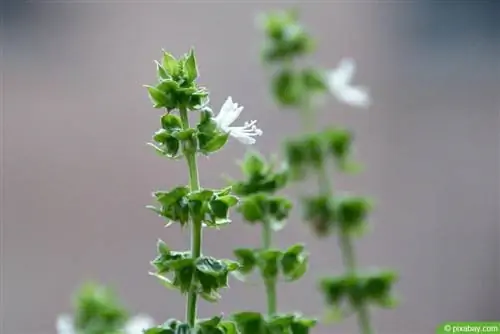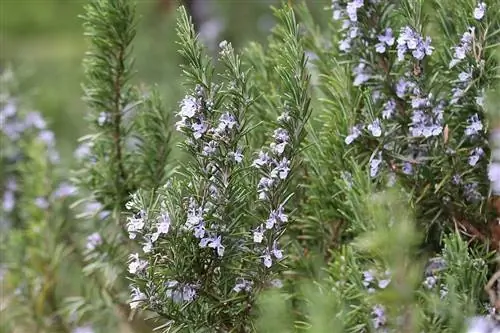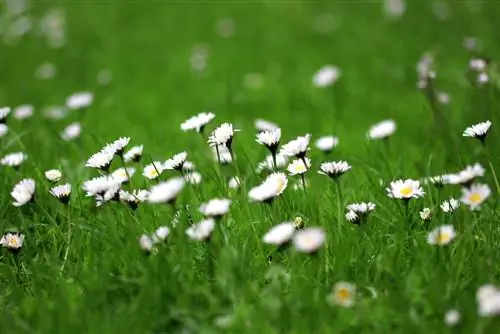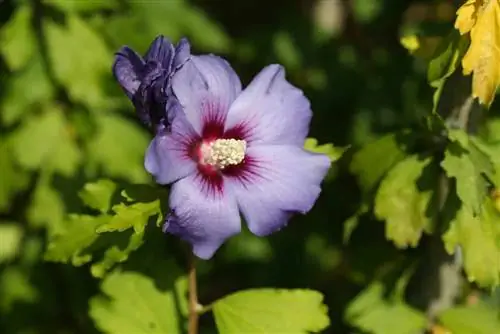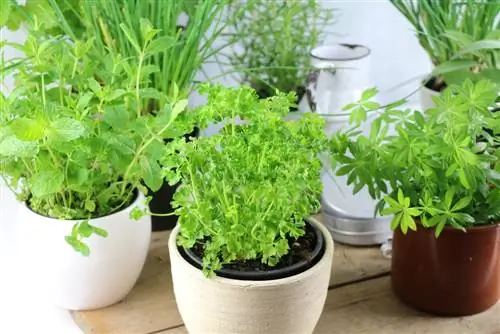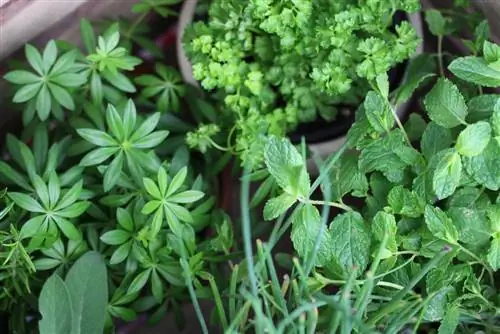- Author admin [email protected].
- Public 2023-12-17 03:39.
- Last modified 2025-01-24 12:45.
Flowering herbs often attract many insects. So they are something good for nature. But what about using it in the kitchen? Can the flowers be eaten safely or does the quality of the entire herb suffer as a result? In fact, there are herbs that should no longer be eaten once they bloom. The following herbs become even more decorative for the kitchen thanks to the flowers.
From A to L
Flowers are often not only beautiful, but for some plants and herbs they can also be very aromatic.
Basil (Ocimum basilicum)
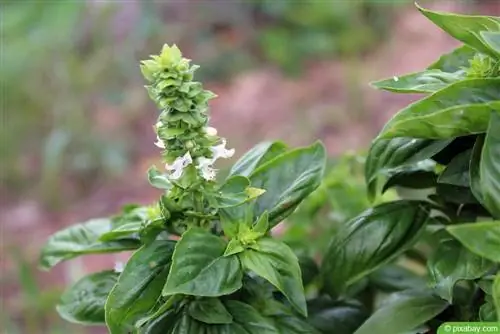
Basil is one of the most commonly used herbs. It is also available in pots in the supermarket. The smell of the leaves is characteristic. Basil produces small, mostly white labial flowers from June to September.
Location and care
- sunny and warm, rather dry
- do not fertilize too rich in nitrogen
- not frost-proof, overwinter indoors
- propagate by seeds or cuttings
- regular pruning promotes new growth
- susceptible to fungal diseases, snails or shoot death
Usage
The culinary herb goes well with many fresh dishes. The small lip blossoms are ideal as a decoration for salads. In addition to the classic green basil, there are also varieties with different leaf or flower colors.
Wild garlic (Allium ursinum)
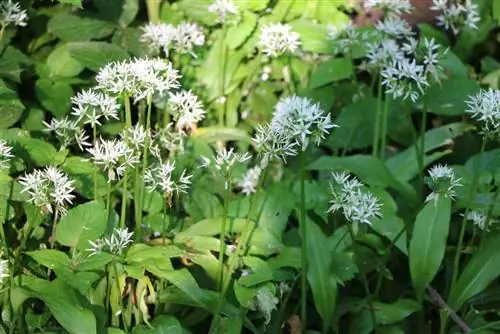
This spring-growing herb is related to chives, garlic and onions. The taste and smell are also reminiscent of garlic. The false umbels, which consist of many individual white flowers, form in April or May.
Location and care
- partially shaded, moist location, soil still permeable, nutrient-rich
- keep moist in dry conditions, mulch
- frost-resistant and reproduces independently
- possibly install a root barrier
- rust fungi can appear or voles eat the onions
Usage
Wild garlic can be eaten fresh, but it is also good to be frozen. Wild garlic butter or pesto can be made from it and the flower buds can be pickled like capers.
Note:
If wild wild garlic is collected in the forest, be sure not to confuse it with potentially poisonous plants.
Borage (Borago officinalis)
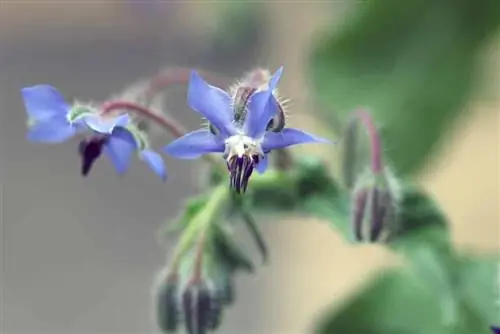
Cucumber herb is particularly popular with insects because the blue or purple flowers attract them in large numbers. They appear from May to July.
Location and care
- likes sun or partial shade, prefers well-drained soil
- must be watered when it is dry, otherwise there is a risk of wilting
- Giving compost supports growth
- often self-sowing
- considered robust against diseases or pests
- Aphids can appear
Usage
The young, soft leaves are particularly suitable for salad. The same applies to the colorful flowers. These are also suitable as decoration for other dishes.
Note:
Excessive consumption of borage should be avoided, otherwise the plant can be poisonous.
Dill (Anethum graveolens)
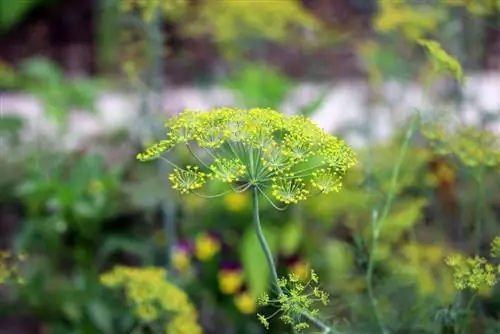
Dill is an umbelliferous plant, similar to carrots or fennel. Mainly the fine pinnate leaves are used, but the yellow flowers that appear in July or August are also edible.
Location and care
- sheltered from the wind, sunny or partial shade
- prefers mixed culture with cucumbers or carrots
- Keep soil moist
- little fertilizer, poor feeder
- Propagation via seeds
- Viral or fungal diseases may occur
Usage
Dill is mostly used fresh, but is also suitable for freezing and drying. It is suitable for salads and fish dishes, but also for pickling cucumbers. In addition to the flowers, the seeds can also be used.
True chamomile (Matricaria chamomilla L.)
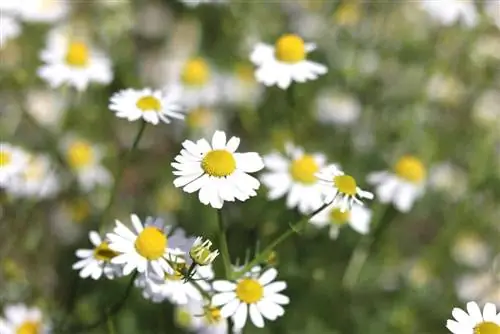
Chamomile is one of the herbs of which the flowers are mainly used. The daisy family blooms from May to September and was previously often found on roadsides and fields. If the wild plant is collected, it should be done away from roads. In fields, the plant may have come into contact with pesticides.
Location and care
- sunny and warm, soil deep and rather dry
- fertilize little and don’t water too much
- cutting back encourages flowering
- Propagation via seeds, light germinators
- Fungal diseases can occur
Usage
Chamomile is often only used as a medicinal plant and the flowers are dried for this purpose. Fresh flowers make a pretty decoration for soups, salads, teas and even cakes or tarts.
Nasturtium (Tropaeolum majus)
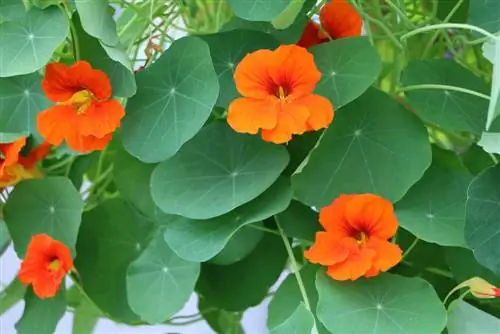
This annual climber is planted primarily for its ability to quickly cover large areas. The flower color ranges from yellow to orange to red. The flowers appear between July and October and are edible.
Location and care
- sheltered, sunny, warm, not too wet
- water regularly
- too much fertilizer promotes leaf growth
- Offer climbing aid, otherwise grows as a ground cover
- Propagation via seeds, self-sowing possible
- Infestation with aphids and butterfly caterpillars possible
Usage
In addition to the flowers, the leaves can also be used in salads. The young buds are suitable for pickling, similar to capers.
From L to Z
With the right idea, you can even create something magical from flowering herbs, and not just in the kitchen.
Lavender (Lavandula angustifolia)
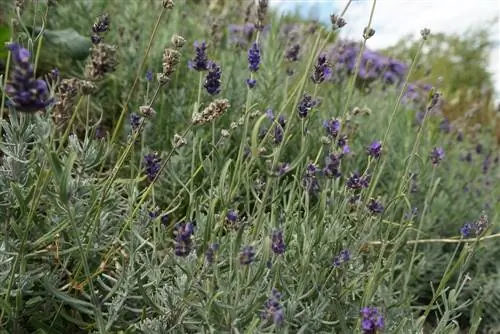
Lavender impresses above all with its pleasant scent, which comes from the blue lip flowers. There are also varieties with purple or red flowers. The flowering period is between June and August.
Location and care
- sunny, warm, well-drained, nutrient-poor
- Too much moisture makes the plant sensitive to frost
- fertilize little
- Propagation via cuttings, seeds are not bad for anyone
- Insensitive, except on wet floors
Usage
Lavender is known for use in scented sachets because the scent of the dried flowers lasts for a very long time. In the kitchen, sweet dishes can be refined with the flowers. Lavender tea is considered a medicinal product.
Marjoram (Origanum majorana)
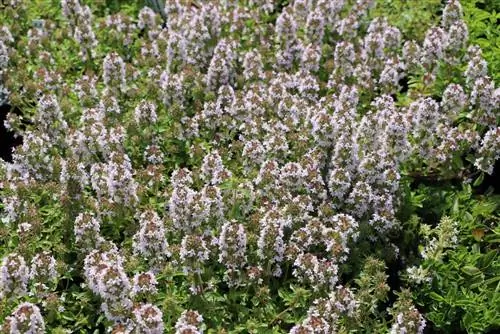
The small, predominantly white lip flowers of the marjoram appear from June to September. They are often visited by bees and other insects.
Location and care
- sunny, sheltered from the wind, calcareous, nutrient-rich soil
- water only when dry
- Compost is sufficient in spring
- not always hardy
- Propagation via seeds
- resistant to diseases and pests
Usage
Marjoram is mainly used to season potato dishes or meat. The leaves and flower stalks dry well. The scent of the flowers lasts for a long time.
Mint (Mentha)
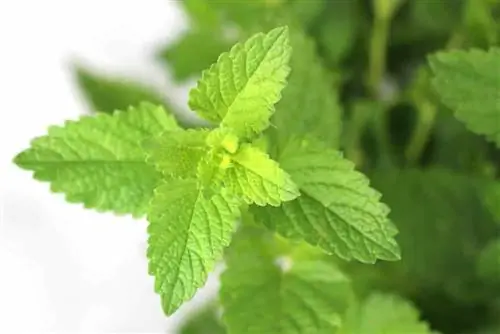
The flower color of the mints can vary depending on the variety. They are usually white or pink flowers that appear in large numbers in summer. The best-known representative of mints is peppermint.
Location and care
- sunny, partially shaded, nutrient-rich
- water regularly
- fertilize now and then
- Root barrier advisable when planting in the bed
- Propagation via cuttings and runners
- susceptible to rust fungi
Usage
Peppermint is considered a remedy; its essential oils are effective against headaches, among other things. In addition, varieties containing menthol are often ingredients in toothpaste or mouthwash. Varieties with less menthol are suitable for use in salads and for seasoning.
Lemon balm (Melissa officinalis)
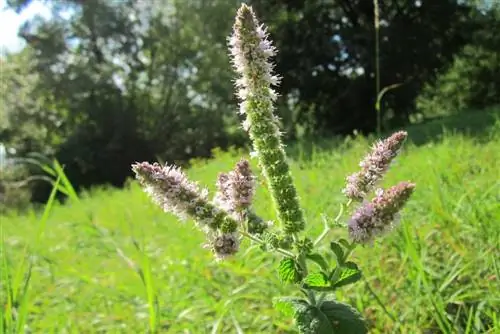
Lemon balm owes its name to the lemony aroma of its leaves. The flowering period of the perennial plant extends from June to August. The small labiate flowers are predominantly white. Lemon balm was originally grown as a pasture for bees.
Location and care
- sunny, partially shaded, protected, not too dry
- keep moderately moist
- don't fertilize too much, weak feeders
- likes to grow, perhaps plan for root barriers
- Propagation via runners, often independent
- robust, pay attention to aphid infestation
Usage
The spicy leaves are suitable as an addition to salads, but also in homemade lemonades or other drinks. Sweet dishes can be decorated with the flowers. When dried, the plant is suitable for use in scented pillows or as a bath additive.

